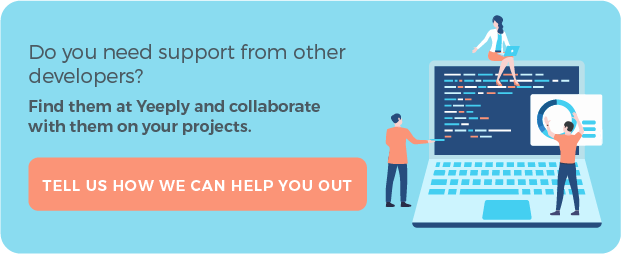In the digital age, creating apps without programming is an increasingly accessible task, thanks to different no code app platforms and no code web application builders that allow anyone, without previous knowledge or with very basic technical notions, delve into the exciting world of mobile phone applications.
This “democratizing” approach involves advantages for people who don’t know how to program, but also for experienced developers who rely on “no-code” to do custom applications fast.
Generically, creating apps for Android without knowing how to program it’s like making a virtual puzzle: the system is based on a module series that can be mounted or dismounted quite intuitively, as we explain below.
Index
- The revolutionary approach to creating apps without programming
- Advantages and disadvantages of creating a no code app
- Platforms and tools to create no code apps without programming
- How developers complement and enhance the “no-code” approach
- Yeeply helps you carry out your app development project
The revolutionary approach to creating apps without programming
The possibility of creating apps using specific no code tools and without any knowledge about how to program is a completely new approach to the digital sector.
It’s about the “no-code” phenomenon, which can be understood, from a practical and economic point of view, as an alternative to rising prices and the difficulties in attracting technological talent.
Many “startups” already develop their digital projects through this type of platform with a simple and intuitive interface which basically just drag and drop modules.
The best example of this form of web “development” are many of the marketplace and online stores that small businesses created during the pandemic (25% of the applications developed in 2020 were made with “no-code”).
If the trend continues, this data could triple by 2025, and that is why the big tech companies have launched platforms such as Thunkable (by Google) or Amazon Honeycode.
Making an app without programming implies some “cons” which we talk about below.
✔️ It may interest you | Create a successful mobile app
Advantages and disadvantages of creating a no code app
Advantages of “no-code” development
Thanks to the “no-code” movement, users with no coding experience needed to create their own websites, apps, online stores and even mobile games.
In addition, the “no-code” movement is user-centric, it allows for easier testing, lowers prices, and makes it easier to fix bugs early.
Other of its advantages are:
- Efficiency. Thanks to this type of platform, programmers and developers from technology companies focus on more complex projects.
- Speed. Today you can make no code mobile apps without programming in just a few minutes. With this type of tools you can also create prototypes, speed up the implementation of the app and streamline your process of commercialization in the market.
- Security. Codeless apps meet security standards and avoid “shadow IT”.
- Error reduction. Being able to create apps without programming makes it easy to customize workflows from existing applications (spreadsheets, ERP, legacy systems) and detect/solve errors.
- Connectivity. “No-code” apps are easily integrated into third-party platforms, which helps to achieve very high connectivity.

Disadvantages of “no-code” development
The so-called “no-code mobile app builders” are useful to create simple applications and for a short lifetime.
If you are looking for more complex or long-term solutions, you can bet on the low code development, that allows you to modify a part of the code and that, therefore, requires minimal programming knowledge.
The vendor lock-in to create an app is a potential risk of these platforms because it limits customization and migration options: when switching from one provider to another, the application may lose its design or part of its functions.
Also, each platform “no-code” has its own positioning and features.
This means that it is not the same to create Android apps without knowing how to program as it is to create apps for the iOS operating system.
In this sense, it is essential to verify that the functionalities of the “no-code” platform chosen are adapted to the expectations and requirements of each project.
Platforms and tools to create no code apps without programming
Between the main no code tools and “no-code” mobile app builders we highlight:
AppSheet
AppSheet is an integrated platform within the suite of tools for Google workspaces, Google Workspace.
With AppSheet, it is possible to create no code applications from spreadsheets Google Sheets in a matter of minutes and without writing a single line of code.
The results are intuitive and flexible no code mobile apps, which facilitate multi-user collaboration.
Typeform
Typeform is the “start” tool to create form type apps.
It has predefined templates, can be integrated into third-party platforms, and offers a free plan to create apps with a cost of zero euros.
AppyPie
Possibly, AppyPie is the best option if you need to create an app for Android and iOS without the need to include programming.
This paid service is very interactive, and you can have your application in just a few minutes.
One of its main advantages is that you can add ads to monetize your apps.
Coda
Well-known platform project management. With Coda you can also create your own apps, from simple to complex, without programming and using a simple text document as a base.
Andromo
Andromo is a tool for the creation of apps for Android without code and in several languages.
It also allows you to add different avenues of monetization or send your app to your contacts by email.
Voiceflow
With Voiceflow you can create voice applications compatible with Amazon Alexa and Google Assistant, no programming required: you just have to choose the flow of actions that will happen as the user activates the voice commands.
How developers complement and enhance the approach “no-code”
Making tasks such as the development of websites, applications or online shops (which until recently were complex) available to companies and users without programming skills, has advantages in terms of funding. And there’s more: it does not mean the “end of developers“, who basically use all these tools to optimize their work.
In fact, developers can use “no-code” platforms to speed up app development or make adjustments to your code quickly, flexibly and promptly thanks to “low-code”.
“Code” developers can take advantage of “no code” tools in several ways
The development of no-code is transforming the software industry, but it doesn’t mean traditional coding will go away. The future will be a combination of no-code and coding, taking advantage of the best of both approaches.
Rapid prototyping
The “no code” tools allow you to create rapid and functional prototypes without the need to write code. Developers can use these tools to quickly iterate and validate concepts before spending time on full implementation.
Automation of repetitive tasks
No-code tools offer automation functionality that can help developers simplify routine tasks. For example, they can use workflow automation tools to manage continuous integration and deployment processes.
MVP development
No-code tools allow developers to quickly create prototypes and MVPs (Minimum Viable Product) without having to write all the code from scratch. This helps them validate ideas quickly and get early feedback from users.
Collaboration with non-technical teams
No-code tools make it easy to collaborate with non-technical teams, like designers or marketers. Developers can use these tools to create intuitive and custom interfaces, allowing them to work more effectively with other teams and speed up the development process.
Skill Expansion
By learning and mastering no-code tools, developers can broaden their skill set and adapt to changing market demands. This allows them to be more versatile and valuable in projects that require a hybrid approach to development.
⭐ It may interest you | Mobile app developers: where and how can I find them?
Yeeply helps you carry out your app development project
In short, no-code platforms broaden access to software development, but coding is still required for custom applications and performance optimizations.
Developers who embrace no-code and evolve will be valuable assets, as their troubleshooting and systems architecture expertise will be crucial. Learning no-code platforms will open up opportunities and allow developers to lead in an ever-evolving field.
Do you want to develop applications for your organization, company or business?
Yeeply puts you in touch with the best professionals to execute both custom applications, such as “no-code” mobile apps or “no code” web apps, and standardized solutions.
Tell us what are your needs and what is your budget, and we will find the perfect professional to take care of your project.








